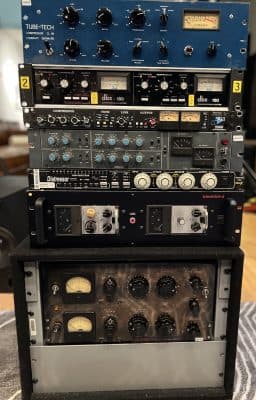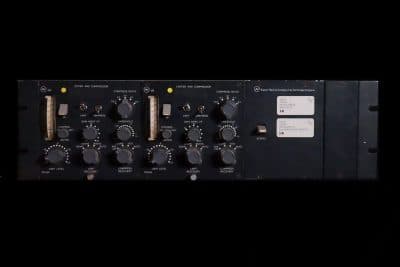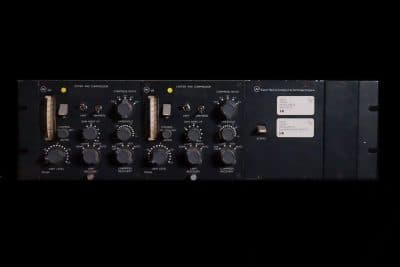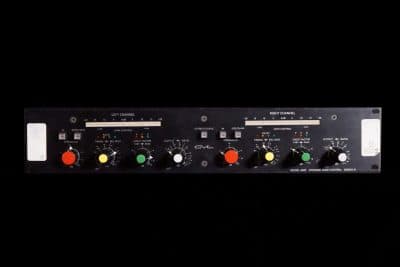Compression Explained
10mins read • Bryan Clark

Jump To Section
What Is Compression?
A confusing topic for budding engineers, producers and musicians who are striving to make their recordings and productions more professional. Compression (put at its simplest) is a way of controlling dynamic range of program material by taming and leveling the loudest parts of musical information relative to the softest parts through gain reduction.
This blog will break down compression into 5 parameters and help you gain a deeper understanding of how to use it to maximum benefit.
There are literally hundreds of compressors on the market ranging from digital plugins to analog rack mounted units. Each one with a different user interface and controls. Some are sparse with only 2 knobs (Teletronix LA-2A) and others offer varying degrees of complexity (GML 8900). To confuse matters further there are different types of compressor circuit design – zener, FET, photocell, optical, solid state and tube based.

The Five Parameters
I’m going to break down compression into 5 core parameters that I call TKARR: Threshold, Knee, Attack, Ratio and Release. It’s a simple nemonic acronym that I hope will help you remember the five parameters more easily. As a bonus it is generally the signal flow order of a compression circuit.

Threshold and Knee
Threshold is a user-set variable that essentially determines when the compressor’s circuit will be engaged based on dynamic range. Think of it as a doorway that allows in a little or a lot of audio information. Low thresholds will allow in large amounts of audio material while high thresholds let in very little – it all depends on your setting.
The knee allows the compressor to ease into action as the audio material gets closer and closer to the threshold’s settings. There are generally two types of knee: hard and soft. Hard knees offer stiffer resistance to audio material approaching the compression threshold and causes the compressor to “snap” into action similar to when your doctor tests your reflexes by tapping just below your kneecap with that triangular shaped rubber mallet (reflex hammer) to trigger a knee-jerk reflex action. Compression can be much more noticeable using hard knee compressors.
Compressors that have a soft knee design are much more forgiving as audio material gets closer to the compression threshold. It offers smoother, less noticeable gain reduction by easing the compressor into action as is characteristc on more vintage tube-based compressors.
Most analog compressors do not offer a choice or control of a knee. This is mostly due to the overall design of the compression circuit itself. For those who are curious, API’s 2500 stereo bus compressor is one such unit that offers full user control over all five parameters.
Allow me to explain this again metaphorically as if you are at a major event (i.e. the Grammys) and you’ve just won! You’ve condensed a lifetime of ‘I’d like to thank’ into 15 seconds and you’ve been regally whisked offstage by an anonymous beauty in a ball gown.
The next thing you are being instructed to do is to leave backstage and go through the giant ballroom (where a band is playing and people are partying) and go to the press room for photo ops and post-win interviews. You walk down the long hallway towards the ballroom door where a burly 6’8” doorman stands behind velvet ropes.
The doorman is the Threshold and the velvet ropes are the Knee. In order for you to get into the ballroom, the doorman has to let you in. As you arrive at the door he takes his hands off the ropes, crosses his arms and coldly stares at you and says “What are doing here? This is for Grammy winners only.” Ouch! He doesn’t recognize you. He only listens to Siberian reggae bands. High Threshold. So high that you can’t pass though.
However, if as you approach he quickly unfastens the ropes (soft Knee) says “I’m a huge fan” and moves aside without you having to break stride. You have crossed the threshold and are now inside the compression ballroom. This is a well set Threshold – only allowing in those who are authorized.
Or perhaps as you arrive at the ballroom entrance, you notice that the doorman has left, the ropes have long been knocked over (soft knee) and anyone can enter. Low threshold, soft knee, and lots of compression in the ballroom. This can be a good thing too! Think of the drum sound on Led Zeppelin’s “When The Levee Breaks”.

Attack
The attack time – how quickly the compressor begins to operate on the program material – is highly variable with most compressors and is most often measured in microseconds and milliseconds. Some compressors may offer preset choices of fixed attack times, while others may allow the user continuous variable control. Most analog compressors fall into these two types.
For an effective attack time, the setting should be timed with the audio material that is being put into the compressor. Audio material that has short attack, decay, sustain and release properties (ADSR) can benefit from attack times that can allow the initial transient information to pass but compress the remaining parameters. For example, drum hits have a much different ADSR envelope than bass, piano, vocals, etc. Therefore attack times should be set accordingly to get the result for which you are striving.
Back to our metaphoric explanation:
As soon as you enter the ballroom, within a microsecond, a waiter comes up to you: “Champagne? The press room is on the other side of the ballroom” – quick Attack.
Or, upon entering the ballroom, you mill around in the crowded room looking for directions and it’s not until you’re in the middle of the ballroom before a waiter comes up to you and shouts: “Drink? Press room is over there.” Medium Attack.
Another version: Upon entering the ballroom you are immediately lost in a sea of people, shouting for directions and hopelessly trying to be heard above the Mötorhead tribute band. Time passes and you somehow find the press room door and a waiter shoves a drink in your hand just before you leave the ballroom. Slow Attack.
All of these settings can be useful and are equally valid depending on what you want the compressor to achieve.

Ratio
Ratio values on compressors typically range from 1.5:1 to ∞:1 (infinity:1). Mathematically that’s just about the biggest range possible. Musically it’s not as wide because what comes out of the compressor will still have dynamic variation. Technically anything above 10:1 ratio is considered to be a limiter. This should help explain why the terms compressor and limiter are often paired together.
For example lets say we’re using a compressor with a 2:1 compression ratio. When the threshold has been passed and audio material has entered into the compression circuit, the amount of resultant dynamic variation will be 1/2 of the amount above the threshold. So if there is a snare drum hit that is 4dB above the threshold, only 2dB will come out. 10dB above the threshold setting? 5dB output will result.
The higher the ratio the more compression/limiting. Using a 10:1 ratio setting, a power chord that is 4dB above the threshold, will result in .4dB of output. Similarly a vocal spike 10dB above the threshold will be reduced to just 1dB of variation at output.
In general analog compressors with very low ratios (1.5:1 to 3:1) are typically used for mastering and are specifically designed to be as transparent as possible.

Release
The release time deals with how quickly the compressor lets go of the audio material and resets. Release times can range from milliseconds to dozens of seconds and can be fixed or continuously variable depending upon the compressor’s design. The setting of the release time can change the character of the audio by adding more ambience to room microphones.
The timing of the release is directly related to the makeup gain (usually labeled “GAIN”) on the compressor. Because traditional compressors REDUCE dynamic range once activated, audio material will be reduced in volume. Thus the need for makeup gain adjustments to get the overall volume of the music material back to the perceived level of when it first went into the compressor. Listen to the volume difference by quickly toggling the compressor from an active to inactive (bypassed) state. In general you want the volume to be a close as possible so that you can really hear what the compressor is doing. Otherwise you’ll be tempted to go with whatever signal is louder.
Having a fast release time will activate the makeup gain function and has the wonderful effect of accentuating the recorded acoustic environment of the audio material. For example, drum overhead mics when run through a compressor with a fast release time will reveal and even enhance the sound of the room in which they were recorded. Again, think of “When The Levee Breaks” or another later Led Zeppelin example “Fool in the Rain”.
Longer release times can glue a mix together by keeping the compressor active well past the initial spike that crossed over the threshold. When coupled with low ratio settings, the resultant audio will sound more homogenized and uniform.

Looking Further
With your new knowledge of TKARR (Threshold, Knee, Attack, Ratio and Release) you now know the main parameters of what is going on inside a compressor regardless whether it’s a plugin or an analog unit.
If you want to dive deeper into compressors and see them in action, I suggest watching our insideblackbird.com videos where we discuss a wide variety of classic compressors in detail.


